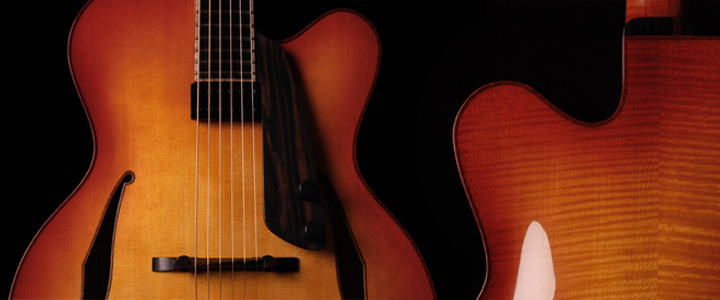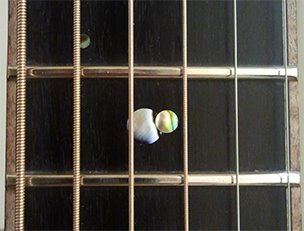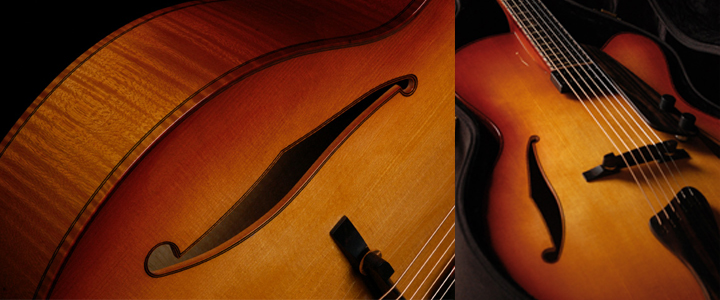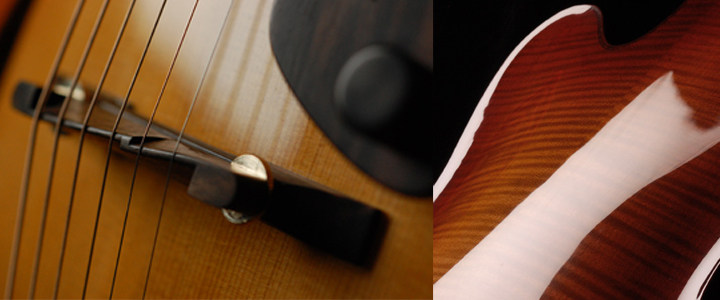“This guitar is a game-changer”, A Blue Line Reviewed
I am always a little nervous handing over a new instrument for the first time. As its maker, I want my work to perform to its highest potential and continue to excel past its initial capabilities. A few weeks ago, Blue Line #0113035 was received by Laurence Yeung. As all new guitars go, from the very first hours of string tension, the guitar is absorbing new energy and becoming accustomed to it all. Like grapes in wine, a guitar needs to ripen and age.
Laurence waited three weeks to write this review. He observed how the guitar changed over this brief time and understood that this was necessary to write a more accurate review. It has been wonderful working for someone who has such an acute awareness of subtle changes. This experience has made me a better guitar builder and for that, I am fortunate to have worked with Laurence.
Here is the full review by Laurence Yeung:
We started, as usual, with Route 66 — it’s not a gig without it — and over the course of three sets and four hours, we went from Nat King Cole and Jobim to Tina Turner and Bryan Adams. This is what we always do, and it is what Lounge-O-Rama does best: We play everything.
There was a big difference last night, however: I brought only one guitar, my 3-week old archtop made by Dan Koentopp. And, for the first time, I gigged with a guitar I love to practice on, and I felt really good about it. I had basically no feedback, tuning, playability, or tonal issues. This guitar is a game-changer.
More than I asked for
Tweety, named serendipitously by George Petit, is a guitar Danny made for me to accomplish 3 things:
- -Sound clear, full, and balanced acoustically
- -Sound sweet and balanced when plugged in at stage volumes
- -Be dead stable during gigs
What he delivered is probably the best-sounding guitar I’ve ever owned, and the only guitar I want to play for the forseeable future (except when we play Journey, of course)
“The tuners are probably the heaviest thing on the guitar,” said Dan when he dropped it off to me. It is really true. Tweety is fantastically light, a pound or more lighter than my other archtop (made by Mark Campellone). Its look was inspired by Jimmy D’Aquisto’s 1993 “Teardrop” guitar and Anthony Wilson’s “Radio Flyer” guitar made by John Monteleone. The result, as you can see, is a sight to behold. For those of you wanting specs:
-Koentopp Blue Line model: 16″ lower bout, 3″ depth
-Neck: 25″ scale (rounded D-shape, 1 23/32″ wide at nut)
-European spruce top (X-braced), flame maple back, sides, and 3-piece neck
-Maple binding, ebony purfling
-Gaboon ebony fingerboard
-Macassar ebony fingerrest/tailpiece/bridge/headstock veneers
-Custom abalone inlay at 12th fret that ended up looking like Theia colliding with a proto-Earth to produce the moon (AWESOME; see above)
-Kent Armstrong floating pickup with volume and tone knobs on the fingerrest
-Nitrocellulose “rust burst” finish
The major structural modification Danny made for me was to decrease the neck pitch. It decreases the downward pressure on the soundboard to curb feedback, but one pays for it with a slightly higher string action; we’re talking fractions of a millimeter here, but as any guitarist will tell you, you can feel it.
Sound
This thing is the lithe, high-performance supercar of guitars. Acoustically, it is incredibly responsive — it is sweet when I want it to be sweet, it barks when I want it to bark (e.g. the theme from “Monk”), and, quite surprisingly, it does a great impression of a flat-top when strummed just so. Its voice, in general, is best described as “round”; the low E string has slightly less low-frequency power than my Campellone, which makes it less “boomy”, while the high B and E strings have a fuller mid-range and a dash of high-end sparkle. To me, this is a brilliant example of X-bracing at work. We can check off goal #1.
Plugged in, I get “my tone” without trying too hard, even with phosphor-bronze strings. Feedback is minimal (not gone), but easy to control: I had to cut through a 3-piece rhythm section with my amp facing me all night, and I didn’t feel like I had to do anything special. That’s all that matters, really. Plus, I checked my tuning after each set and it never strayed more than a couple cents from what it was at the beginning. Goals #2 and #3? Accomplished, with bells on.
What came as a delightful surprise was how well Tweety handles tunes outside the traditional jazz idiom. Part way through Elvis’ Suspicious Minds I remember thinking to myself, “Wow. I wish I brought my other amp — the one with the tube-bias tremelo. That would really make the bridge section.” Contrast this with the usual dialogue in my head if Pat calls out a tune like that and all I have is an archtop: “S**t. This is gonna sound terrible, but okay…” To be fair, the tone can never get not quite as jangly as it needs to be, but honestly, it did a bang-up job.
Pobody’s nerfect
No guitar is perfect. There are small things, generally minor issues, that could be improved on Tweety, but they do not alter the fundamentally remarkable nature of the instrument. None of these are deal-breakers, and I write these down with the utmost respect and admiration to Danny and his luthiery. He knows about them already.
- The setup on the B-string. There was an imperfection on the nut end that made the B-string sound a little muffled at first. I smoothed it out myself, and it was good enough for me to be happy during these first 3 weeks. I think it can improve even more once I am able to part with Tweety and leave it with my tech.
- Intonation in the upper registers. Tweety gets a few cents sharp in the upper registers, and the sharpness is not even across the strings. I must stress that this is a small issue — no guitar has perfect intonation, and we usually mitigate these concerns for our purposes by tuning strings slightly sharp or slightly flat. There is a very good reason for this sharpness in particular, however: Danny “scoops” the neck at the body just a little to avoid the “bump” that develops there on older instruments. I’m willing to live with that, and my tech may be able to finesse this to my liking anyway.
- The tonal balance is incredibly sensitive to the bridge. This could go either way, depending on your needs and temperament. Like I said, Tweety is the supercar of guitars, so when perfectly tuned up, it’s incredible. Nudge anything out of alignment, however, and it won’t be at peak performance. I discovered a drop in balance and volume when I moved the bridge, starting at 1 mm from its initial position, when trying to compensate for the intonation issue above. So, I quickly returned the bridge to its original position. This behavior is not unexpected for an archtop; it’s just the first time I’ve ever been able to notice. On the one hand, the fact that I can hear a tonal difference means that Tweety is extremely well-made and optimized. On the other hand, I’m not sure what this means in the long term.
Conclusion: Damn.
Danny has made me a guitar that excites me, surprises me, and makes me want to play it all the time. It was crafted with care, by hand, from blocks of wood, simple tools, and perspiration. It has the soul of its maker in it: The classical guitar training, the years of restoring and studying Stradivarius and Guarneri violins and cellos, and, most importantly, his energy and vitality.
He’s only 29, yet he’s making instruments like this — of a caliber that makes me want to sell all the others I own. Sure, it’s got imperfections. Some might choose to call that character. It’s the kind of stuff that makes you want to keep it around.







You deserve it DK. The instruments sing for themselves, and the level of craftsmanship is only echoed and endorsed by everyone who owns your guitars, amigo. Way to be.
Thanks Evan! That means a lot to me!
Dan … WOW! That is a beauty! You do amazing work!
Thank you for the kind words Robert! I really appreciate it!
I met Dan a couple of years ago at a guitar festival in Macomb, Illinois, and it’s great to see that he’s getting the recognition he richly deserves for his archtops. Bravo!
Quite an instrument.
Thanks John!
Thank you so much Bill, I really appreciate it!